Cite this document
(“Season of migration to the North Case Study Example | Topics and Well Written Essays - 1000 words”, n.d.)
Season of migration to the North Case Study Example | Topics and Well Written Essays - 1000 words. Retrieved from https://studentshare.org/literature/1598271-season-of-migration-to-the-north
Season of migration to the North Case Study Example | Topics and Well Written Essays - 1000 words. Retrieved from https://studentshare.org/literature/1598271-season-of-migration-to-the-north
(Season of Migration to the North Case Study Example | Topics and Well Written Essays - 1000 Words)
Season of Migration to the North Case Study Example | Topics and Well Written Essays - 1000 Words. https://studentshare.org/literature/1598271-season-of-migration-to-the-north.
Season of Migration to the North Case Study Example | Topics and Well Written Essays - 1000 Words. https://studentshare.org/literature/1598271-season-of-migration-to-the-north.
“Season of Migration to the North Case Study Example | Topics and Well Written Essays - 1000 Words”, n.d. https://studentshare.org/literature/1598271-season-of-migration-to-the-north.


